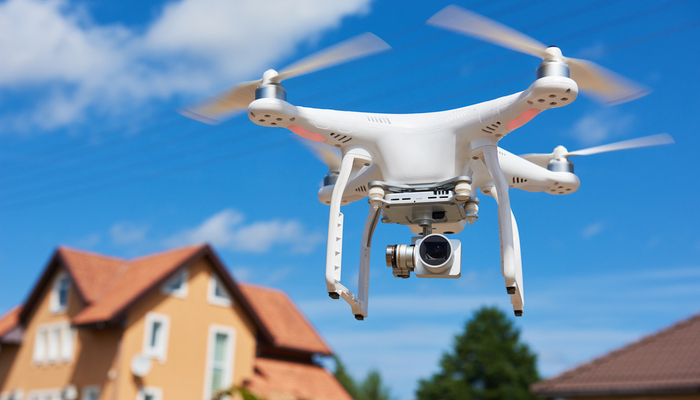Using drones is the next evolution in real estate photography and marketing. If you haven’t already started using drones for your real estate photography, you may want to consider adding it to your toolkit.

Drones are a cost-effective way to shoot elevated photos or video of a listing. Decent models that will get this job done start at just a few hundred dollars, making it a relatively inexpensive investment in your business.
This means that you can master flying a drone and offer this service to your clients, without having to hire a drone pilot.
Uses for Drones in Real Estate
Drones are obviously very useful to show aerial views of the entire property, which can come in handy especially for large plots of land or properties with amazing features. That’s not the only use for them, though.
Real estate agents can use drones to show potential buyers the neighborhood and surrounding area, including how close the home is to desirable amenities.
Use a drone to show off a brand new roof, or high-up architectural details that are hard to access otherwise. Take the potential buyer for a “walk” to the neighborhood pool.
Commercial UAS Rules
As with other aircraft, drones (unmanned aircraft system, or UAS) are regulated by the FAA. It must weigh less than 55 pounds, and be registered with the FAA. The UAS can only fly during the daytime, must stay below 400 feet, and can’t fly faster than 100 mph.
When operating the UAS, you have to keep it within sight, and you can’t fly it from a moving vehicle. For real estate use, you’ll likely only be flying in residential areas, but you should be aware of the no-fly zones for any UAS.
You can’t fly them in or over stadiums and other sports events, in the District of Columbia, less than five miles from any airport, or near emergency response efforts (like a forest fire).
UAS Etiquette
UAS etiquette rules aren’t really laws, but are more so common sense rules that you should adhere to when operating a drone.
You should always ask a homeowner for permission before launching a UAS to fly around their home. Even though you know that the photos or video is a benefit to your clients, you should still make sure that they are comfortable with it.
In fact, you shouldn’t fly over any private property without permission. When flying a drone, you should stay away from crowds of people. This could pose a safety problem for both the crowd and your drone.
Along the same lines, you should also avoid flying near animals, who could feel threatened by the drone, or do damage to the drone.
Becoming a Drone Pilot
If you’re ready to take the leap and add drone photography to your marketing, the FAA requires a few steps to get you certified as a pilot. First things first: you need to be at least 16 years old, and able to understand, read, speak, and write in English.
You’ll have to pass the initial aeronautical knowledge test. There are plenty of Knowledge Testing Centers that can administer the test. Check with the FAA for the updated list to find a location near you. Once you’ve passed your test, you’ll complete a form for the FAA for a remote pilot certificate.
After passing the TSA security background check and internal processing is complete, the FAA will mail your remote pilot certificate, and you’ll be ready to hit the skies! Just don’t forget to renew your remote pilot certificate every two years.











